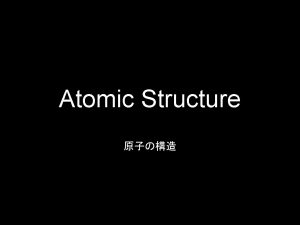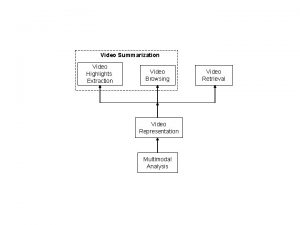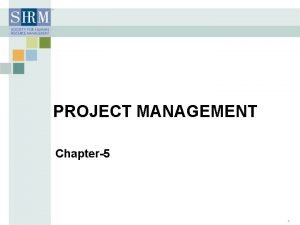International Project Management Introductory video The following video


















































- Slides: 50

International Project Management

Introductory video ▶ The following video gives an overview of the content that will be covered in this unit of the course https: //www. youtube. com/watch? v=34 v 4 FUxeqb. Q

Managing an International Project ▶ This section will discuss managing an international project. ▶ The following slides will define: ▶ What is meant by an “international project” ▶ Some recent examples of international projects ▶ Qualities which make international projects a success ▶ The main risks and hurdles involved ▶ Commonly used frameworks ▶ Case Studies of international projects

Recommended Texts ▶ ▶ International Project Management: Leadership in Complex Environments ▶ Thomas W. Grisham ▶ ISBN: 978 -0 -470 -57882 -7 International Project Management ▶ Bennet P. Lientz, Kathryn P. Rea ▶ ISBN-13: 978 -0124499850 ▶ ISBN-10: 0124499856

What is an International Project? ▶ Linkedin defines International project management as the management of projects internationally or across borders and cultures. ▶ International project management has become increasingly prominent in the global business world in recent years. ▶ This is largely due to globalisation as companies aim to increase their market share or utilise better or more economic resources abroad.

Some Examples of International Projects ▶ The Channel tunnel ▶ Disneyland Paris ▶ New Delhi Athletes Village

Challenges involved in International projects ▶ There a number of challenges to be over come by a project manager and any project team members which are involved in an international project. ▶ Each international project comes with its own unique set of challenges and risks however there are some common issues that occur in almost all international projects.

Risks to International projects Political Economic Cultural Legal Other War Currency exchange Cultural differences Different Laws Different environment Governmentco Inflation ntrol Language barrier Different dispute resolution Import/export regulations Subsidy Tax Public resistance Legislation Financing Infrastructure Lack of experience

Political risks ▶ Political risks range from government policy to potential uprisings and war. Its not always possible to predict changes in the political landscape of a country. ▶ Change in government policies ▶ Change of government ▶ Political uprising ▶ War ▶ Government subsidies

Economic risks ▶ Aside from the economic risk which is associated with most projects. An International project comes with additional risk factors. ▶ changes in exchange rates ▶ payment made in different currencies ▶ Inflation in host countries ▶ Tax rates

Cultural ▶ Cultural differences have a huge impact on a project. Being understanding of different cultures and values is extremely important in managing moral and progress in a project. ▶ Being aware that different countries have different work practices and social practices ▶ Being able to manage any language barriers ▶ Public resistance from local community, can often come into play

Legal ▶ It is important to be aware that the host country may have different Laws on certain issues ▶ Dispute resolution processes can also differ from country to country

Other ▶ There is also other influences that can hinder a project ▶ Environmental/ climate ▶ Import and export regulations may differ ▶ There may be a lack of experience or skills in the host country

Key Skills ▶ In order to effectively manage an international project it is important to have a grasp of the following skills ▶ Intercultural communication skills ▶ Adaptation skills ▶ Willingness to learn ▶ Cultural understanding ▶ Extensive knowledge base

Key Personal and Social Skills ▶ The following skills are critical for personnel on the project to possess ▶ Intercultural communication skills – ability to make oneself understood in a respectful manner to colleagues of a different culture ▶ Adaptation skills – the ability of key employees to adapt to working and possibly living in a new environment with different cultures. ▶ Willingness to learn ways and management practices of local colleagues and listen to and consult colleagues in decision making processes.

Key Personal and Social Skills ▶ An understanding of the cultures involved ie. national, organisational etc and the influences these cultures have on the lives of workers and their work practices ▶ An extensive Knowledge of the host country and a desire to continually expand that knowledge as the project develops.

Internationally Effective Organizations ▶ Organizations contemplating international projects should focus themselves in specializing the following 10 areas: ▶ Examine and prioritize motives and strategic objectives. These should be consistent with those of a partner organization. This will enable a positive and harmonious relationship ▶ Be clear on and ensure agreement with partners on operational goals and performance targets ▶ Set realistic objectives and performance targets

Internationally Effective Organizations ▶ Have clear governance mechanisms as well as clear definitions of the roles and responsibilities of the partner organizations ▶ Seek out the views of local partners and stakeholders in the community and integrate the best of the management traditions of the host country ▶ Ensure commitment of senior management at headquarters by having a project champion and providing services to ease the life of colleagues ▶ Constantly assess the social, political and economic environment of the project, considering the project’s feasibility in the first place, making adjustments during implementation, and having programs to consult with and influence local and international stakeholders and build community support

Internationally Effective Organizations ▶ Recognize the importance culture has on project management and in response, select and train personnel to be culturally sensitive and effective collaborators with people of another culture. ▶ Trust your partners until given reason otherwise

Frameworks ▶ Listed in this section are frameworks which are commonly referred to when managing an international project ▶ The four frameworks and theories explained in this section are: ▶ PESTLE ▶ Hofstedes 5 dimensions ▶ Country analysis ▶ SWOT analysis

Country Analysis ▶ Country analysis is the process of building a picture of the national business environment ▶ The framework has 3 main components: ▶ ▶ Strategy ▶ Context ▶ Performance The country analysis involves the examination of a country’s economic, social and political environment. The analysis should offer a comprehensive overview of a country.

Country Analysis ▶ Strategy – A country’s national strategy is reflected in the goals and policies of the decision makers. The country analysis should describe the strategy from government statements and actions as well as non state actors. ▶ Context – The contextual part focuses on the nation’s resources and its ability to utilize those resources ▶ Performance – This assesses how well the country is doing economically, politically and socially


Country Analysis example ▶ Link to country analysis of Tanzania: ▶ https: //www. slideshare. net/Murendeni. Munyai/tanzania-country-analysisfinal-45790590

SWOT analysis ▶ SWOT is an acronym for: strengths, weaknesses, opportunities and threat ▶ It is used to analyse and identify the key factors which could make or break a business/ project

SWOT Analysis ▶ Strengths: The business’s characteristics which give it the upper hand over competitors ▶ Weaknesses: The negative attributes of the business which hinder its growth and operation ▶ Opportunities: factors which the business or project could look to exploit to gain an advantage ▶ Threats: elements which could be harmful to the business/ project

International Project example ▶ This business case from the health care industry is a good example for global project management ▶ The industry has increasingly experienced specialization and customization of product services and deliveries. ▶ Pressure to maintain profit margin and increase costs, has required health care products and service delivery organizations to examine their own infrastructure and identify areas for improved performance. ▶ The reorientation of the industry is closely monitored and regulated (for example by the American Food and Drug Administration FDA).

Introduction ▶ The Project concerns with a $100 million business transformation ▶ The transformation was aimed to create a single corporate identity with common business processes and systems to take full advantage of the company's global presence ▶ The project was planned to be managed at the company's major sites in the U. S. and Europe. ▶ During the two years the project team consisted of around 70 people. Internal staff as well as external advisors were recruited in equal number. ▶ The project team consisted of employees from all main company facilities to ensure access to the respective cultural, business, and process expertise

Difficulties ▶ The presented business case displays internationality. Project teams comprising of both international external advisors and employees of the global company created a multicultural team atmosphere. ▶ To make complicate things the culture clash was not the only obstacle to overcome the company was just recently created as a joint venture. Therefore, by starting this transformation initiative, different corporate cultures within this company were still present and had to be managed.

How Were the Difficulties Overcome ▶ Support from senior management was ensured through active sponsorship management, which was also used to manage expectations. ▶ During the course of the project, feedback-generating workshops were held to reveal and overcome existing resistance and to create a game plan for the successful continuation of the project

Methodologies and Approaches Which Made the Project Successful ▶ Program Management - Program Management is the efficient implementation of multiple projects, which are managed in a coordinated fashion which allows the benefits to be recognised that otherwise would go unnoticed if each project was managed as a separate entity.

Methodologies and Approaches Which Made the Project Successful ▶ Program Organization- The global project organization was divided into seven main categories with each of them represented by a team with highly skilled team members: ▶ 1. Finance/Controlling ▶ 2. Sales and Distribution ▶ 3. Material Management and Logistics ▶ 4. Production and Production Planning ▶ 5. Quality management ▶ 6. Plant Maintenance ▶ 7. Training

Methodologies and Approaches Which Made the Project Successful ▶ Communication Management - Communication Management aims to develop a targeted and suitable communication strategy by using a communication plan as well as using different communication channels such as newsletters, training's, interviews, meetings, hotlines, web pages, conference calls. Two-way communication channels (e. g. meetings) were set up to share information and address concerns before, during, and after the implementation of change.

Homework ▶ There are other methodologies that were used that made this project successful. These include ▶ Knowledge Transfer ▶ Culture management ▶ Using the following link : ▶ https: //www. pmi. org/learning/library/managing-international-cross-cultural -projects-8924 ▶ Read over the methodologies and lessons learnt and write about how these methodologies are important and could be applied to other projects

Why International Projects Fail WITH RELEVANT CASE STUDIES

Recommended Reading ▶ Lientz B and Rea K (2003). International Project Management. United States of America: Academic Press. 8 -14. ▶ Koster K (2010). International Project Management. Great Britain: SAGE Learning. ▶ Hill C (2012). International Business- Competing in a Global Marketplace. Spain: Mcgraw Hill.

What makes International Projects Different Attribute Standard Projects International Projects Organisations Single Multiple organisations and departments each with their own selfinterest Systems and Technology Homogenous Multiple systems that require local knowledge and support Society Single and Common Culture Multiple Varied Cultures Company Culture Single Could be the same across borders however most likely to be varied due to local factors Organisations Can be focused on the project Many other competing demands for resources Self-Interest More easily Understood More Complex to Understand Regulations Understood and Known Harder to understand- more subject to interpretation

Complexities of International Projects Political Uncertainty Different Time Zones Greater Visibility to the World Lack of Control Different Currencies Complexities Different Rules and Regulations Different Organizational Structures and strategies Different Cultures both national and possibly organisational Different Taxes and Tariffs

Reasons for Failure It is estimated that around 50% of all International Projects either fail, are not completed or do not deliver the expected targets (Wimmers & Optiz, 2010) Failure Lack of Managerial Expertise and Leadership Qualities Undermining the Project and a lack of planning, unclear objectives and limited resource allocation Not Fully Understanding Culture Entering the wrong Environment (Set Up to fail)- Macroeconomic and political factors

Theoretical Framework ▶ One of the main reasons for failure is due to firms entering the wrong or more commonly not understanding the environment (Hill, 2012) ▶ To achieve the above organisations can use theoretical frameworks and implement them into practice ▶ However it has to be acknowledged that frameworks are not always the answer to problems ▶ They should be used with caution ▶ A combination of Frameworks is likely to produce more accurate findings

PESTLE Analysis Political Taxes and tariffs Labour Law Political Stability Corruption Subsidising Economic Exchange Rates Interest Rates Economic Growth - GDP Inflation Rates Cost of Raw Materials Social Technology Legal Environmental Research and Development Consumer Law Climate Age Distribution Access to Technology Health and Safety Law Geographical Location Education Levels Cost of Technology Copyright/Pat ent law Cultural Trends Emerging Technologies `Employment Law Attitude to Clean Energy Changes in Lifestyle Technology Transfer Availability Competitive Regulations Pollution Populations Growth Waste Disposal Laws

PESTLE Analysis Continued Advantages Disadvantages An easy to understand simple model Hard to measure some variables e. g corruption Does give an insight into Macroeconomic factors and a deeper understanding of the environment Gathering all the information needed for a full pestle analysis is difficult Can help identify threats and opportunities Factors are highly likely to change and unforeseen events can have a massive impact on the results of the analysis Cost Effective- only cost is time and for an organisation the employees collecting and analysing the data Organisations can restrict who is involved in the analysis

Hofstede’s 5 Dimensions of Culture Individualism/collectivism Power Distance Uncertainty Avoidance Masculine/feminine Time Orientation Do members of a culture prefer to be viewed as individuals or as part of a group/team The degree of centralisation of authority. Low power distance scores imply a closer between “power” and “ordinary” people How comfortable people are with risk/change Hard or Soft Values- is it achievement or nurture? Long-term perspective, planning for the future, forward thinking vs short term and present orientation • Hofstede (1984) defined culture as the collective programming of the mind • Identified 5 dimensions to help breakdown and understand culture • Created country scores for each dimension that can be found at https: //www. hofstedeinsights. com/product/comparecountries/ • One of the key factors that facilitate failure is culture- this model therefore can give project managers a deeper understanding of culture.

Hofstede’s 5 Dimensions of Culture Continued Main limitations ▶ Data Collected from not just one industry but one company- IBM. Are the results a reflection of IBM’s corporate culture across national borders? ▶ Subcultures Exist- The United kingdom score reflects 4 different countries that have different cultures ▶ Is 5 dimensions enough to fully identify culture? ▶ Research was conducted in 1984 therefore the data is out of date • Although the model has clear limitations it is still implemented in practice extensively across the world- are there any better models? • Managers need to use this model with caution but it does address one of the key issues of international project failure- not understanding culture • Perhaps a more contemporary study is the – The GLOBE Study http: //globeproject. com

Leadership (Expatriates) ▶ As identified a key reason for failure is managers lacking expertise and leadership qualities needed for international projects ▶ International managers arguably need more competencies and behavior traits/skills than a domestic manager ▶ Awareness of an environment does not necessary provide competence in an international project ▶ Nearly 40% of American Expats return early from an international assignment/project due to fearing identify loss and are unable to cope with new stressors (Sanchez et al, 2000) ▶ In some international projects the ability to create a dual identification is extremely challenging

Leadership (Expatriates) Continued Be able to learn and unlearn Have a “cultural general” approach Emotional Energy Willing to share power Physiological Maturity Competencies, traits and skills Motivation to be away from home for long periods of time Cognitive Complexity Ego Strength Flexibility Linguistic ability Able to accept tolerance and uncertainty Interpersona l Skills Patience and Respect

Conclusions Clearly there is a common theme in what makes international projects successful and what makes them a failure. ▶ Attention to Cultural Issues, the traits and skills of not only managers but employees assigned on the international project and understanding the environment of where the project will be occurring all help to reduce the probability of failure. ▶ However sometimes International Projects fail even when the above criteria is met- Ikea in Saudi Arabia (Case Study Attached) ▶ The likelihood is that in this shrinking world there is going to be a dramatic increase in international projects therefore a greater understanding and most importantly learning lessons from other failed assignments is necessary. ▶

Assessment (15% of Overall Grade) ▶ There are 5 case studies attached! ▶ Students pick 3 and answer the questions provided. ▶ Each Case Study is worth 5%

References ▶ https: //www. linkedin. com/pulse/20140707010713 -44256597 -internationalproject-management-a-tool-for-success ▶ http: //citeseerx. ist. psu. edu/viewdoc/download? doi=10. 1. 1. 551. 7938&rep=r ep 1&type=pdf ▶ https: //www. pmi. org/learning/library/managing-international-cross-cultural -projects-8924 ▶ https: //www. slideshare. net/anjanverma/country-analysis-15400021 ▶ https: //www. slideshare. net/Sujen. Nisha/countryattractiveness ▶ http: //articles. bplans. com/how-to-perform-swot-analysis/

References ▶ Lientz B and Rea K (2003). International Project Management. United States of America: Academic Press. 10 ▶ Wimmers J and Optiz C (2010). Challenges and Best Practices in International Projects. Germany: Grim. 6. ▶ Hill C (2012). International Business- Competing in a Global Marketplace. Spain: Mcgraw Hill. 126. ▶ Hofstede, G. (1984). Culture’s consequences: International differences in work-related values. Newbury Park, CA: Sage. ▶ Sanchez J, Spector P & Cooper C. (2000). Adapting to a boundaryless world: A developmental expatriate model. Academy of Management Executive. 1 (1), 103.
 International project example
International project example Introduction for project
Introduction for project The role of project management in achieving project success
The role of project management in achieving project success Modern project profiles in spm
Modern project profiles in spm Cost duration graph
Cost duration graph Introduction to project management kathy schwalbe
Introduction to project management kathy schwalbe Software project evaluation
Software project evaluation Perpetual project closure
Perpetual project closure Ms project agile template
Ms project agile template Types of project termination
Types of project termination Hát kết hợp bộ gõ cơ thể
Hát kết hợp bộ gõ cơ thể Ng-html
Ng-html Bổ thể
Bổ thể Tỉ lệ cơ thể trẻ em
Tỉ lệ cơ thể trẻ em Gấu đi như thế nào
Gấu đi như thế nào Tư thế worm breton
Tư thế worm breton Chúa yêu trần thế
Chúa yêu trần thế Các môn thể thao bắt đầu bằng từ đua
Các môn thể thao bắt đầu bằng từ đua Thế nào là hệ số cao nhất
Thế nào là hệ số cao nhất Các châu lục và đại dương trên thế giới
Các châu lục và đại dương trên thế giới Công thức tính độ biến thiên đông lượng
Công thức tính độ biến thiên đông lượng Trời xanh đây là của chúng ta thể thơ
Trời xanh đây là của chúng ta thể thơ Cách giải mật thư tọa độ
Cách giải mật thư tọa độ Làm thế nào để 102-1=99
Làm thế nào để 102-1=99 Phản ứng thế ankan
Phản ứng thế ankan Các châu lục và đại dương trên thế giới
Các châu lục và đại dương trên thế giới Thể thơ truyền thống
Thể thơ truyền thống Quá trình desamine hóa có thể tạo ra
Quá trình desamine hóa có thể tạo ra Một số thể thơ truyền thống
Một số thể thơ truyền thống Bàn tay mà dây bẩn
Bàn tay mà dây bẩn Vẽ hình chiếu vuông góc của vật thể sau
Vẽ hình chiếu vuông góc của vật thể sau Biện pháp chống mỏi cơ
Biện pháp chống mỏi cơ đặc điểm cơ thể của người tối cổ
đặc điểm cơ thể của người tối cổ Thứ tự các dấu thăng giáng ở hóa biểu
Thứ tự các dấu thăng giáng ở hóa biểu Vẽ hình chiếu đứng bằng cạnh của vật thể
Vẽ hình chiếu đứng bằng cạnh của vật thể Phối cảnh
Phối cảnh Thẻ vin
Thẻ vin đại từ thay thế
đại từ thay thế điện thế nghỉ
điện thế nghỉ Tư thế ngồi viết
Tư thế ngồi viết Diễn thế sinh thái là
Diễn thế sinh thái là Dạng đột biến một nhiễm là
Dạng đột biến một nhiễm là Các số nguyên tố là gì
Các số nguyên tố là gì Tư thế ngồi viết
Tư thế ngồi viết Lời thề hippocrates
Lời thề hippocrates Thiếu nhi thế giới liên hoan
Thiếu nhi thế giới liên hoan ưu thế lai là gì
ưu thế lai là gì Khi nào hổ con có thể sống độc lập
Khi nào hổ con có thể sống độc lập Khi nào hổ mẹ dạy hổ con săn mồi
Khi nào hổ mẹ dạy hổ con săn mồi Hệ hô hấp
Hệ hô hấp Từ ngữ thể hiện lòng nhân hậu
Từ ngữ thể hiện lòng nhân hậu










































































